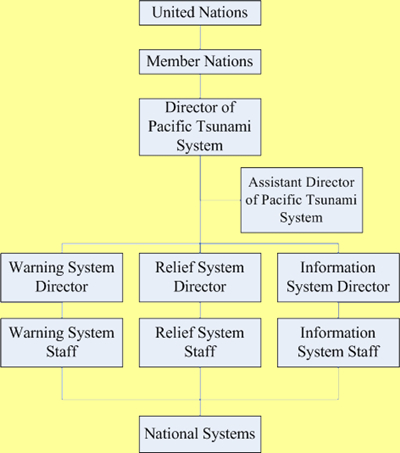

| This page summarizes the information presented in the funding and cooperation pages. See the funding and coordination pages for references. |
|
Neither Peru nor Micronesia can afford to construct a system. Because of the international aspect of the organization, the international community will more readily cover the costs of the system.
NGO's would provide more of the expertise and the supplies to create the supply depots. The US would still take a lesser role to that of other nations who would increase their contributions to the system. |
||||||||||
|
Long term funding for the system would most likely follow that which was used in the initial creation of the system. However, once the system is established, it would become the director's responsibility to prepare a budget for submission to the nations. The nations would then decide amongst themselves how they would meet the budget for the next year. |
||||||||||
|
Relief would be coordinated through the central relief agency of the network. The agency would work to ensure supplies arrived quickly and efficiently to the nations that needed them. The supply depots would cover the people until international aid could arrive. Medical assistance would be mobilized immediately and first priority would be given to nations with little existing medical infrastructure, such as Micronesia. |
||||||||||
|
The creation of a new Pacific system would draw many supporters. The United States would be behind the project because they would be removing some of the responsibility off of themselves along with part of the costs. Other nations would be increasing their influence in the system, which would give them reason to participate. Overall, the system would be consolidated. This makes the system better in the long term, giving yet another reason to participate. |
||||||||||
|
The system would be created underneath the United Nations, with the nations who are a member of the system being able to have voice in the system. A director would be in charge of the system to facilitated communication and similar direction between the directors of the warning, relief and information system. The warning director and staff would be in control of the warning network for the Pacific along with the alarm system. The relief director and staff would be in charge of making arrangements for aid before a tsunami and in coordinating relief efforts after a tsunami, including the management of NGO's. The information system director and staff would take over the role of the ITIC, advocating for tsunami networks and holding forums about tsunamis. |
||||||||||
|
If a warning was triggered on a local buoy, the warning would immediately trigger the evacuation notice in that nation. The signal would proceed to that government as well as the International Pacific Tsunami Warning Center (IPTWC). The IPTWC would then look at the data to confirm that a tsunami was present. It would either confirm the tsunami by triggering its alarms for that country or shut down the system in the case of a false alarm. In either case, a confirmation call would be given to the national government as a check to make sure that the system distributed properly. If a tsunami was present, the IPTWC would then trigger its other alarms and set the entire system in motion. |
||||||||||
|
The organization would be created under the Intergovernmental Oceanographic Commission (IOC), the organization that coordinates international efforts regarding the oceans. Under this, it would absorb the International Tsunami Information Center (ITIC), which would then operate underneath the information director. The Pacific Tsunami Warning Center (PTWC) would also be included within the organization. Any relief efforts that would take place in other UN organizations would also be displaced and placed under the relief director when a tsunami occurs. |
||||||||||








